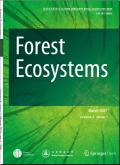Dieback of spruce plantations: Deadwood stands and management heterogeneity enhance beetle diversity and habitat connectivity
IF 3.8
1区 农林科学
Q1 FORESTRY
引用次数: 0
Abstract
Forest ecosystems are important for biodiversity conservation and human societies, but are under pressure due to climate change and human interventions. This applies to natural forests as well as tree plantations. The latter are globally widespread and therefore gaining increasing importance for biodiversity conservation. However, even after dieback due to increasing disturbance frequencies, such plantations are primarily managed for economic returns, leading to growing conflicts among stakeholders. In particular, the impact of forest management on biodiversity is being discussed. This study investigates the effects of five management approaches in a landscape severely affected by spruce (Picea abies L.) dieback on beetle diversity, conservation, and community composition. We considered direct effects of management and indirect effects of environmental parameters separately in ground-dwelling and flight-active beetles. Beetle diversity was strongly affected by forest management, with non-intervention deadwood stands being most beneficial for beetles. In addition, we show indirect effects of environmental factors. In general, parameters related to salvage logging (e.g. open canopies, tree stumps) influenced beetle diversity and conservation negatively, while positive effects were found for soil nutrient availability and plant species richness. Community composition differed strongly among management categories and indicated a lack of landscape connectivity for open habitat species, as we found only low proportions of such species even on salvage-logged sites. We propose a mixture of management approaches after bark beetle outbreaks, including a substantial proportion of non-intervention deadwood stands, to increase landscape heterogeneity and connectivity. This may increase overall biodiversity while addressing the concerns of both forestry and species conservation.
云杉人工林枯死:枯木林分和管理异质性增强了甲虫多样性和栖息地连通性
森林生态系统对生物多样性保护和人类社会具有重要意义,但由于气候变化和人类干预,森林生态系统正面临压力。这既适用于天然林,也适用于人工林。后者在全球广泛分布,因此对生物多样性保护越来越重要。然而,即使在因干扰频率增加而枯死之后,这类种植园的管理主要是为了经济回报,导致利益相关者之间的冲突日益加剧。特别是正在讨论森林管理对生物多样性的影响。研究了在云杉(Picea abies L.)枯死严重影响的景观中,五种管理方法对甲虫多样性、保护和群落组成的影响。我们分别考虑了管理的直接影响和环境参数对地栖和飞栖甲虫的间接影响。森林管理对甲虫多样性的影响较大,无干预的枯木林分对甲虫最有利。此外,我们还揭示了环境因素的间接影响。总体而言,与回收采伐相关的参数(如开放冠层、树桩)对甲虫多样性和保护有负面影响,而对土壤养分有效性和植物物种丰富度有积极影响。群落组成在不同的管理类别之间存在明显差异,表明开放生境物种缺乏景观连通性,即使在回收砍伐的地点也只发现了低比例的此类物种。我们提出了树皮甲虫爆发后的混合管理方法,包括相当比例的非干预枯木林分,以增加景观异质性和连通性。这可以增加整体生物多样性,同时解决林业和物种保护的问题。
本文章由计算机程序翻译,如有差异,请以英文原文为准。
求助全文
约1分钟内获得全文
求助全文
来源期刊

Forest Ecosystems
Environmental Science-Nature and Landscape Conservation
CiteScore
7.10
自引率
4.90%
发文量
1115
审稿时长
22 days
期刊介绍:
Forest Ecosystems is an open access, peer-reviewed journal publishing scientific communications from any discipline that can provide interesting contributions about the structure and dynamics of "natural" and "domesticated" forest ecosystems, and their services to people. The journal welcomes innovative science as well as application oriented work that will enhance understanding of woody plant communities. Very specific studies are welcome if they are part of a thematic series that provides some holistic perspective that is of general interest.
 求助内容:
求助内容: 应助结果提醒方式:
应助结果提醒方式:


